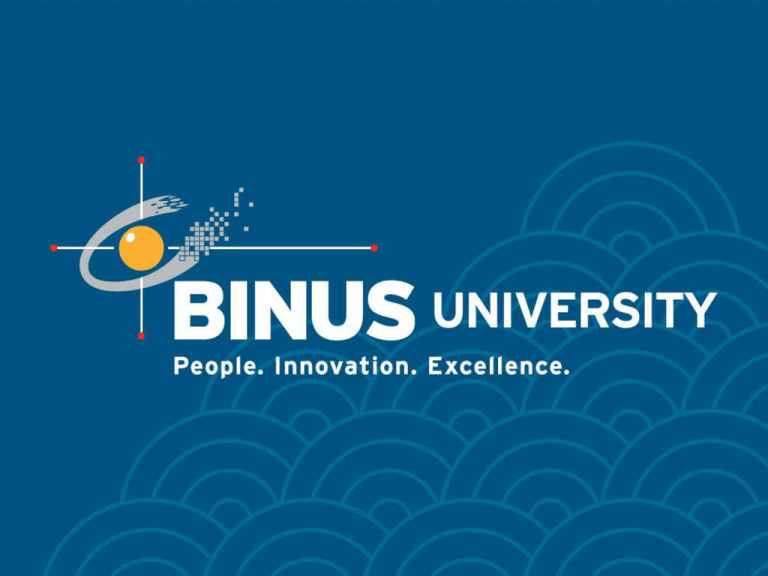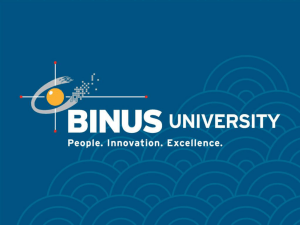Document 15063079
advertisement

Course Name: Business Intelligence Year: 2009 Common Mistakes on Business Intelligence 23rd Meeting Source of this Material (1). Williams, Steve & Williams, Nancy (2007). The Profit Impact of Business Intelligence. Chapter 8 Bina Nusantara University 3 CSF: Establishing the Value Proposition The first step to BI success is to establish a clear understanding of how business performance can be improved by investing in a BI program and to define the scope of the BI initiative. Establishing the scope of the BI initiative is a vital first step and prerequisite for defining the value proposition. These activities set the foundation for everything to follow. • Mistake #1: No Explicit Alignment Between BI Strategy and Business Strategy It is clear that aligning resource allocation decisions with business strategy is just as important for BI competitiveness. One of the most common and critical mistakes is the lack of explicit alignment between BI strategy and business strategy (Figure 231). • Mistake #2: Not Knowing How to Define Information Requirements It is critical to understand the details of the information requirements and how they relate back to supporting the business. Because business users have been trained over the years by information technology (IT) departments to provide reporting Bina Nusantara University 4 CSF: Establishing the Value Proposition (cont…) specifications for operational system reporting, these business users reasonably think that information requirements should be defined as reporting requirements. • Mistake #3: Not Marketing the Vision to Obtain Organizational Support Many organizations are surprised to discover that it’s not good enough merely to develop a BI/DW application and train business users-not if they want to ensure that the application will be used. This approach, which is common for operational systems, does not always work. One reason for its failure is that many organizations consider BI/DW applications to be optional. Figure 23-1 Bina Nusantara University 5 CSF: Establishing and Managing a BI Program BI applications are interdependent and need to be managed within a program context. This interdependency includes BI projects sharing such things as tools and technologies, data architecture, standards, methodologies, and ETL processes. Many BI mistakes result from not fully appreciating the need to manage a BI initiative as a series of projects managed within a unified program. • Mistake #4: Using Ad Hoc Practices to Select and Fund BI Projects Organizations that use a structured approach to evaluate and determine the relative cost/benefit of competing BI project efforts are more likely to make optimal use of their BI investment. • Mistake #5: Providing Inadequate Governance for the BI Program Management Companies set a course for success when they understand the goals and opportunities of a BI initiative and provide adequate resources for both a BI program governance structure and BI project level activities. Organizations that invest in formal BI program governance in support of all BI projects make a wise investment and avoid expensive future problems associated with a project-centric approach to BI. Bina Nusantara University 6 CSF: Establishing and Managing a BI Program (cont…) • Mistake #6: Establishing De Facto Program Governance Based on the Initial BI Project Organizations that use the initial BI project to make long-ranging decisions that will affect future projects are risking expensive mistakes. • Mistake #7: Not Strategically Positioning the BI in the Business Organization Organizations are on the right track when they appreciate that BI is far more that reporting and can serve as an important tool to advance their competitive position in the marketplace. These organizations tend to view BI as a new strategic tool that has great potential if applied properly. • Mistake #8: Not Providing Adequate Resources and Funding for Supporting Efforts Needed for a Successful BI Initiative Organizations that recognize the need for and provide the resources and funding for supporting efforts needed to support a BI program will be laying the groundwork for success. Bina Nusantara University 7 CSF: Optimizing IT infrastructure for BI Most business users believe that IT is just IT; they don’t understand that there can be distinctly different needs for different classes of systems. If BI is truly being positioned in the company as a strategic tool to improve bottom-line performance, then it needs to be considered by itself and given equal consideration to be successful. • Mistake #9: Using a Technical Infrastructure That Does Not Adequately Support BI Organizations that recognize the need to invest in a technical infrastructure optimized to support BI requirements will avoid technical risks that lead to performance problems. • Mistake #10: Using Operational System IT Design and Development Approaches Organizations that recognize that different design and development approaches are needed to support BI requirements will avoid quality and performance problems. Bina Nusantara University 8 CSF: Optimizing IT infrastructure for BI (cont…) • Mistake #11: Using IT standards and Policies Designed for Operating Systems Organizations that review and revise exiting IT standards and policies to ensure that the policies adequately support BI program needs will be more successful in developing and deploying BI applications. Bina Nusantara University 9 CSF: Managing Organizational Change Needed to Capture Value Managing organizational change is critical to ensuring that the BI asset, once built, is put to good use to deliver bottom-line results. Organizations also are often unwilling to make changes needed to operational systems to ensure that the information they need to run the business is available and of high quality. • Mistake #12: Not Utilizing Business Process Reengineering Approaches to Optimize the Use of New BI Capabilities Organizations that manage organizational and business process changes needed to capture the value of the BI asset are more likely to achieve a good return on their investment. • Mistake #13: Unwillingness to Make the Organizational Changes Needed to Obtain Data Needed to Deliver BI BI is about change, in addition to business users needing to adjust to new informational capabilities, changes are also often required so that the organization can capture new types of data needed to provide a BI capability and to ensure the quality of that data. Bina Nusantara University 10 CSF: Managing Organizational Change Needed to Capture Value (cont…) • Mistake #14: Not Creating Organizational Incentives Organizations that recognize the need to institutionalize the use of BI assets through creating organizational incentives are more likely to capture the potential ROI of their BI asset. • Mistake #15: Not Exploiting the Full Potential of Information Some organizations, by nature, resist change and will only embrace it when forced to. Other organizations are so focused on the present that they don’t seem to have the organizational bandwidth to fully exploit the possibilities. Bina Nusantara University 11 “The structure that a mature enterprise takes on at any point in time essentially represents the accumulation of a long series of prior resource allocation decisions….. If these decisions are made without a coherent guiding philosophy or strategy, the organization that results will be like a stalagmite: shapeless, inefficient, and of little usefulness.” -Robert Hayes, Steven Wheelwright, and Kim Clark, Dynamic Manufacturing End of Slide Bina Nusantara University 12


